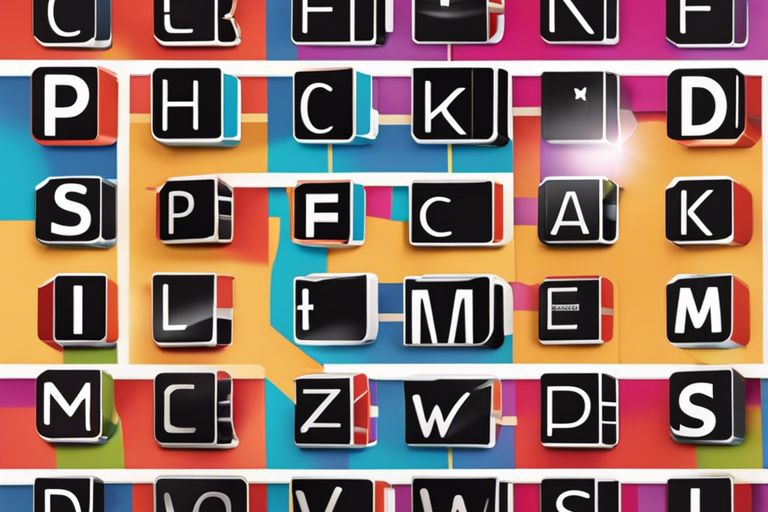Embark on your phonics journey as we unravel the complexities of decoding and encoding, delving into the world of phonemes and graphemes. From blending consonant clusters to mastering vowel digraphs, this comprehensive guide will equip you with the crucial tools to enhance your reading skills. Step by step, we navigate through the stages of phonics learning, empowering you to decode the mystery of language and transform your literacy capabilities. Whether you’re just starting out or looking to refine your phonics expertise, this guide is your key to unlocking the secrets of the English language. Join us in this educational adventure and take your reading abilities to new heights!
Key Takeaways:
- Phonics Basics: Phonics is a method used in UK primary schools to teach children to read by connecting sounds (phonemes) to symbols (graphemes).
- Decoding and Blending: Children progress from decoding individual letter sounds to blending them to form whole words, starting with CVC words and advancing to consonant clusters and digraphs.
- Encoding and Spelling: Alongside reading, children must practice encoding by spelling words correctly, progressing to understanding spelling rules and suffixes in later years.
Unravelling the Mystery of Phonics
What is Phonics?
It is necessary to understand Phonics as the method of teaching children to read by linking sounds (phonemes) and the symbols that represent them (graphemes). In primary schools in the UK today, Phonics is the predominant learning-to-read approach. Children are taught to decode words by recognising the sounds represented by different letters.
The Evolution of Phonics Instruction
The history of Phonics instruction has seen a significant shift towards emphasising decoding skills in early years education. This shift aims to equip children with the ability to process letter sounds and blend them into words effectively. The adoption and evolution of Phonics instruction have been driven by research that demonstrates its effectiveness in boosting reading proficiency among young learners.
Phonics vs. Other Reading Methods
Instruction in Phonics differs from other reading methods, such as whole language or sight-word approaches, as it provides a systematic and structured way of teaching children to decode words. Research has shown that Phonics instruction can lead to improved reading skills and comprehension abilities in young learners compared to alternative approaches.
The Science Behind Phonics
Understanding Cognitive and Linguistic Foundations
Science shows us that phonics is rooted in the fundamental cognitive and linguistic abilities of the human brain. It involves linking individual sounds (phonemes) to the symbols that represent them (graphemes). This process helps children understand the building blocks of language and how they come together to form words.
The Role of Phonemic Awareness
On the journey of mastering phonics, phonemic awareness plays a crucial role. This skill involves being able to hear, identify, and manipulate phonemes in spoken words. By developing phonemic awareness, children gain a deeper understanding of the sounds that make up the words they read and write.
The Alphabetic Principle in Action
One key aspect of phonics is the alphabetic principle, which teaches children that letters represent sounds in our language. By understanding this principle, young learners can decode words more effectively and improve their spelling skills. This foundational concept forms the basis for successful reading and writing development.
Research-Evidence Supporting Phonics
The effectiveness of phonics instruction is well-supported by research evidence. Studies have shown that systematic phonics teaching significantly enhances children’s reading abilities and overall literacy skills. With a structured approach to phonics, students can build a strong foundation for reading success.
Core Principles of Phonics Instruction
Systematic Instruction: The Building Blocks of Phonics
Blocks of systematic instruction form the foundation of phonics learning. By breaking down language into phonemes and graphemes, children are able to decode and encode words effectively. This structured approach ensures a solid understanding of letter-sound relationships, setting the stage for successful reading development.
Explicit Instruction: The Roadmap to Reading
Instruction in phonics provides a clear roadmap for developing reading skills. By explicitly teaching the relationship between sounds and letters, children gain the necessary tools for decoding and spelling words accurately. This direct instruction method enhances phonemic awareness and lays the groundwork for proficient reading.
Understanding the importance of consistency and review helps to reinforce phonics skills effectively. Gradually progressing through sequencing activities, starting with single letter sounds and moving towards more complex digraphs and blends, maximises the impact of phonics instruction. This strategic approach ensures that children build a strong foundation in phonics, setting them up for reading success.
Sequencing Skills for Maximum Impact
Maximum impact is achieved through carefully sequenced phonics instruction. By introducing letter sounds in a logical progression and gradually incorporating more complex phonetic patterns, children develop strong decoding skills. This sequential approach enhances reading fluency and comprehension, making phonics instruction highly effective in improving literacy outcomes.
The Importance of Consistent Practice and Review
Building on phonics skills requires consistent practice and review. Regular reinforcement of letter-sound relationships and word decoding abilities ensures retention and mastery. Engaging in daily reading activities and practising spelling and decoding exercises helps solidify phonics knowledge, leading to long-term reading proficiency.
Essential Phonics Skills and Strategies
Decoding: The Heart of Phonics
With phonics being the cornerstone of early reading skills, decoding plays a vital role in connecting sounds with symbols. Children learn to recognise letters and their corresponding sounds, laying the foundation for literacy.
Blending Sounds into Words
Into the next phase, children progress to blending sounds into cohesive words, enhancing their ability to read fluently. By seamlessly combining individual sounds, they unlock the magic of language and comprehension.
It’s in this critical stage that children hone their ability to blend sounds together, creating meaningful words and sentences that form the basis of their reading abilities. Practice, patience, and guidance are key elements in mastering this imperative skill.
Segmenting Words into Sounds
The process of segmenting words into sounds involves breaking down words into individual phonetic components. This allows children to understand the structure of words and aids in spelling and language development.
The ability to segment words into sounds empowers children to recognise the building blocks of language, enhancing their spelling and writing skills. Through practice and guidance, they gain confidence in manipulating sounds to form words accurately.
Strategies for Effective Phonics Learning
An effective phonics learning strategy involves a comprehensive approach that incorporates decoding, blending, and segmenting skills. By integrating these key elements into structured lessons, children can develop a strong foundation in reading and literacy.
Exploring different strategies such as interactive games, word building exercises, and phonics-based activities can enhance learning outcomes and engage children in the process. Consistent practice and reinforcement of phonics principles are imperative for long-term reading success.
Overcoming Common Phonics Challenges
Identifying and Addressing Phoneme Difficulties
After delving into the world of phonics, it’s not uncommon to encounter challenges with identifying and articulating phonemes. Overcoming these difficulties involves targeted practice and reinforcement of the smallest units of sound in the English language. By focusing on accurate pronunciation and recognising the corresponding graphemes, children can improve their phonemic awareness and boost their reading skills.
Troubleshooting Blending and Segmenting Hurdles
An imperative aspect of phonics learning is the ability to seamlessly blend and segment sounds to form words. However, students may face obstacles in mastering this skill. By providing ample opportunities for blending exercises and segmenting practice, educators can help learners overcome these hurdles. Offering support through interactive activities and targeted interventions can make a significant difference in enhancing phonics proficiency.
Blending and segmenting are foundational skills that facilitate the transition from individual phonemes to complete words. Encouraging students to break down words into their component sounds and blend them back together fosters fluency and comprehension in reading.
Personalizing Phonics Instruction for Diverse Learners
Segmenting phonics instruction to cater to diverse learning needs is crucial for ensuring all students reach their full potential. Personalised approaches such as differentiated instruction, multi-sensory techniques, and individualised learning plans can effectively support learners with varying levels of phonics proficiency. By tailoring teaching strategies to meet the unique requirements of each student, educators can foster a supportive and inclusive learning environment.
Segmenting phonics instruction is a proactive way to address the diverse learning needs within a classroom setting. By adapting teaching methods to accommodate individual strengths and challenges, educators can create a more inclusive and effective learning experience for all students.
Phonics plays a fundamental role in developing strong literacy skills, and overcoming common challenges in phonics learning is imperative for academic success. By addressing specific difficulties related to phonemes, blending, segmenting, and personalising instruction, educators can empower students to unlock the mysteries of reading and enhance their overall language proficiency.
Phonics in Practice: Activities and Resources
Activities for Classroom Instruction
One effective activity for classroom instruction is to use letter cards to help children decode and blend sounds into words. This hands-on approach can engage students and reinforce phonics skills effectively.
Phonics Games for Engaging Practice
Practice phonics through interactive games such as bingo, word matching, or phonics puzzles. These games not only make learning enjoyable but also help children solidify their understanding of phonetic concepts.
It is imperative to create a variety of games that cater to different learning styles and abilities, ensuring that all children can participate and benefit from the engaging practice.
Home-Based Exercises for Parents and Children
Engaging in activities such as creating word family flashcards, reading together, or playing phonics-based online games can enhance phonics skills in a home setting. These interactive exercises make learning enjoyable and reinforce phonetic understanding.
Parents can also involve children in everyday activities that incorporate phonics, such as spelling out words while cooking or identifying letter sounds in the environment, to further enhance their reading skills at home.
Curated List of Phonics Resources
Phonics resources like online phonics games, interactive worksheets, and phonics apps can provide additional support for children to practise and reinforce their phonics skills outside the classroom. These resources offer a variety of activities that cater to different learning preferences and levels.
Exercises incorporating visual aids, audio clips, and interactive elements can enhance engagement and make the learning process more enjoyable for children as they work on mastering phonics.
Phonics and Technology: Digital Tools and Apps
Utilizing Technology for Interactive Phonics Learning
Interactive digital tools and apps have revolutionised the way phonics is taught, making learning more engaging and effective. Keep children actively involved in their education by using interactive platforms that provide immediate feedback and tailored learning experiences based on their progress. These tech-savvy approaches can enhance phonics skills and boost reading proficiency in a fun and interactive way.
Reviewing the Best Educational Apps for Phonics
Apps designed for phonics learning offer a wide array of features, from interactive games to personalised exercises that cater to individual learning goals. These educational apps provide a convenient way for children to practise phonics skills anytime, anywhere. By incorporating engaging activities and adaptive learning techniques, these apps can significantly support a child’s phonics development and overall reading comprehension.
Navigating the Path Forward: Beyond Phonics
Integrating Phonics with Other Literacy Skills
With a solid foundation in phonics, it’s important to integrate this knowledge with other literacy skills to enhance overall reading abilities. By incorporating phonics with comprehension, fluency, and vocabulary development, you can further strengthen your reading capabilities and enjoy a richer reading experience.
Strategies for Advanced Literacy Development
For advanced literacy development, consider the following strategies:
- Regular Reading: Reading a variety of texts regularly
- Writing Practice: Engaging in writing activities to reinforce spelling and grammar skills
Strategies for advanced literacy development are crucial for honing your reading and writing skills to a higher level. By implementing these strategies, you can continue to enhance your proficiency in decoding, comprehension, and expression.
Lifelong Learning: Continuing the Reading Journey
Development in reading should be seen as a lifelong journey. As you progress beyond the basics of phonics, exploring complex texts, engaging in critical analysis, and expanding your vocabulary are key components to evolving as a proficient reader. Continuous exposure to various genres and challenging materials will further enrich your reading skills and foster a love for learning through literature.
Advanced literacy skills are cultivated through consistent practice, diverse reading experiences, and a thirst for knowledge. Embrace the ongoing journey of reading as a pathway to intellectual growth and personal enrichment.
Inclusivity in Phonics Instruction
Adapting Phonics for Special Educational Needs
For children with special educational needs, adapting phonics instruction is crucial to ensure everyone can benefit from the learning process. Tailoring teaching methods to cater to individual needs, such as providing multi-sensory activities or visual aids, can help support children with varying abilities in phonics acquisition. It is necessary to consider each child’s unique learning style and adjust teaching techniques accordingly to promote inclusivity in phonics education.
Cultural Sensitivity in Phonics Materials and Teaching
Cultural sensitivity in phonics teaching involves considering the diverse backgrounds and experiences of students to create an inclusive learning environment. By incorporating materials and examples that reflect the cultural diversity of the students, teachers can make phonics instruction more engaging and relevant to all learners. This approach fosters a sense of belonging and respect for different cultural perspectives within the classroom.
Educational
Bilingualism and Phonics: Strategies for Success
Sensitivity to bilingualism in phonics instruction is necessary for supporting students who speak multiple languages. Implementing strategies that acknowledge and utilise a child’s bilingualism can enhance phonics learning and language development. Encouraging the use of both languages in phonics activities, providing bilingual resources, and celebrating linguistic diversity can empower bilingual learners to excel in phonics and literacy skills.
Phonics
Phonics instruction forms the foundation of reading skills development, with children progressing through various stages of decoding and encoding to master phoneme-grapheme relationships. By incorporating inclusive practices that cater to diverse needs, cultural sensitivities, and bilingualism, educators can ensure that all students receive effective phonics instruction that supports their literacy growth.
Phonics for Different Ages and Stages
Foundations: Phonics Foundations in Early Childhood
To establish a solid foundation in phonics in early childhood, children are introduced to phonemes and graphemes, decoding and encoding, digraphs and trigraphs. Learning to link sounds and symbols paves the way for reading fluency. Children in Reception start by learning letter sounds and gradually progress to blending sounds into words. Encouraging children to practise both reading and writing phonemes is key to phonics success.
Different: Building on Phonics Skills in Elementary Years
As children progress into the elementary years, they build on their phonics skills by decoding CVC words, exploring consonant clusters, and mastering vowel and consonant digraphs. By Year 2, they examine spelling rules and advanced concepts like silent letters and specific endings. The evolution of phonics learning in these formative years sets the stage for proficient reading and writing abilities.
Building: Adult Learners: Taking on Phonics Later in Life
Adult learners begining on phonics later in life can also benefit greatly from structured phonics programmes. By developing decoding and encoding skills, mastering digraphs and trigraphs, and learning spelling rules, adults can enhance their reading and writing abilities. Setting aside dedicated time for phonics practice and utilising resources tailored for adult learners can lead to significant progress in literacy skills.
The Educator’s Toolkit for Phonics Instruction
Professional Development for Phonics Teaching
All educators looking to enhance their phonics teaching skills should invest time in professional development. Understanding the phonemes and graphemes, decoding and encoding concepts, as well as digraphs and trigraphs, is crucial. By honing these skills, teachers can effectively impart phonics knowledge to their students, laying a strong foundation for reading proficiency. Continuous learning through workshops, courses, and collaboration with peers can further enhance teaching techniques.
Building a Phonics-Rich Classroom Environment
Creating a phonics-rich classroom environment is vital for fostering literacy skills. Incorporating phonics games, wall charts displaying phonemes and graphemes, and a variety of reading materials can immerse students in phonics learning. The classroom should be a space where students feel encouraged to practice decoding and encoding words, helping them progress through different phonics learning stages with confidence. Visual aids, interactive activities, and a print-rich environment can greatly support phonics instruction.
Collaboration and Community in Phonics Education
Engaging in collaboration and building a community focused on phonics education can amplify learning outcomes. By sharing best practices, resources, and lesson ideas with fellow educators, teachers can refine their phonics teaching methods. Additionally, involving parents and caregivers in the phonics learning process can extend support beyond the classroom. Establishing a network of phonics educators allows for ongoing professional growth and enrichment in phonics education.
Reaping the Benefits: The Outcomes of Effective Phonics Instruction
The Connection Between Phonics and Reading Comprehension
Phonics plays a vital role in enhancing reading comprehension skills. By mastering phonics, individuals are equipped with the ability to decode words accurately, leading to improved fluency and understanding of written text. Research shows that a strong foundation in phonics correlates significantly with higher levels of reading comprehension, ultimately empowering readers to engage with and comprehend a wide range of texts.
Phonics and Its Impact on Writing Skills
Between phonics instruction and writing proficiency lies a strong connection. As individuals develop their phonics skills, they not only become proficient readers but also effective writers. Understanding the relationship between sounds and letters enables individuals to spell words correctly and express themselves cohesively in writing. A solid grasp of phonics paves the way for enhanced written communication skills, contributing to overall literacy development.
Plus,
The Ripple Effects of Reading Confidence
Reading proficiency achieved through phonics instruction has a ripple effect on overall confidence and motivation in literacy. Individuals who master phonics experience a boost in their reading skills, leading to increased confidence in tackling various texts and genres. This newfound reading confidence extends beyond academic success, positively impacting communication skills, critical thinking abilities, and overall self-esteem.
It is evident that effective phonics instruction not only enhances reading and writing skills but also fosters a sense of confidence and empowerment in individuals’ literacy journeys.
To wrap up
Presently armed with a comprehensive understanding of phonics, you are equipped to navigate the intricate world of reading with confidence and proficiency. By mastering the art of decoding phonemes and graphemes, blending sounds effortlessly, and delving into vowel and consonant digraphs, you have laid a solid foundation for enhancing your reading skills. As you progress through the stages of phonics learning, from CVC words to complex consonant clusters and vowel digraphs, you will continue to unlock the mysteries of language and communication. Bear in mind, practice makes perfect, so immerse yourself in a plethora of age-appropriate texts and engage in spelling exercises to reinforce your newfound knowledge. With dedication and perseverance, you are well on your way to becoming a proficient reader and speller, ready to conquer any literary challenge that comes your way.
Frequently Asked Questions
Q: What is phonics and why is it important?
A: Phonics is a method of teaching children to read by linking sounds (phonemes) and the symbols that represent them (graphemes). It is crucial in helping children build a strong foundation in reading and spelling skills.
Q: How do children learn phonics?
A: Children are taught letter sounds in Reception, starting with basic phonemes like s, a, t, n, i, p. They progress to blending sounds to form words, decoding CVC words, exploring consonant clusters, vowel digraphs, and consonant digraphs.
Q: What is the difference between decoding and encoding in phonics?
A: Decoding in phonics refers to the process of reading by translating symbols into sounds, while encoding involves the process of spelling and writing words by hearing and representing the sounds with symbols.










